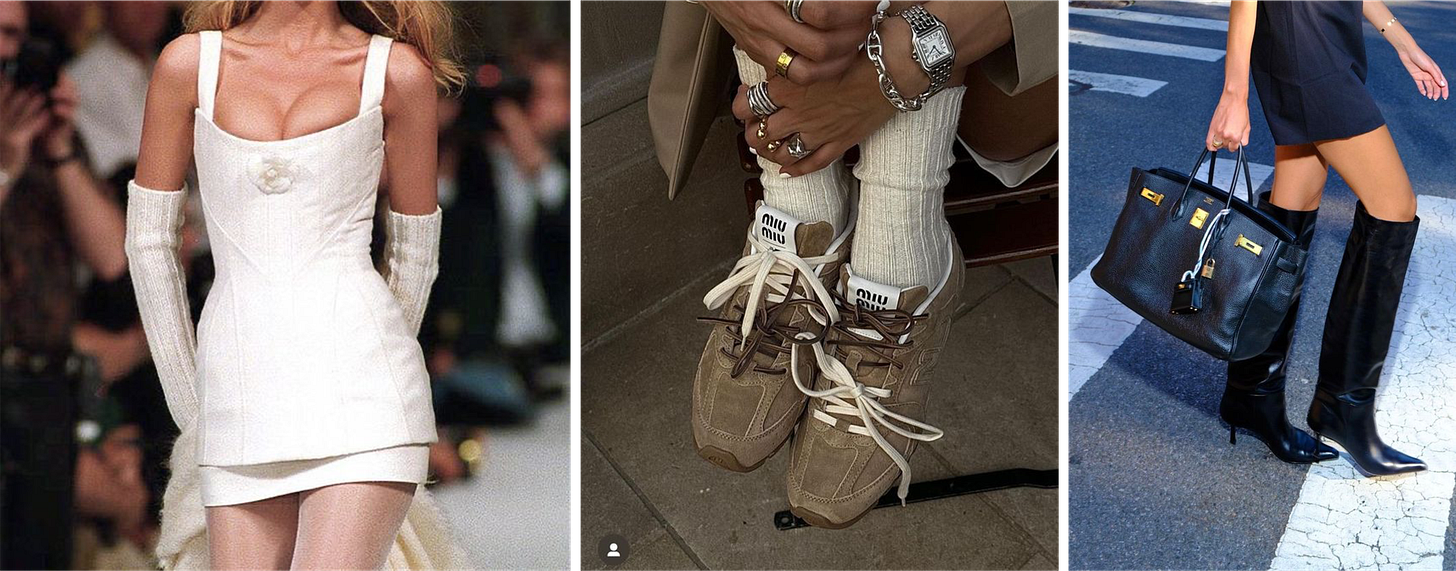Bag charms, return of the aspirational shopper & niche is the new mass
"I have a brand. Should I start a Substack?"
Hello!

I trust you’ve all had a beautiful week. Mine was buoyed by the fact that I had a gorgeous, quintessentially-London weekend. My bf’s mother was in town so we took her to all the hotspots. Sketch, River Café, our local pub, etc.
A personal highlight was dinner on Friday night. We went to this gorgeous East-London restaurant, Brawn in Bethnal Green. When we sat down, the waiter proceeded to tell us that his recommendation was to get a starter and a main each. No small plate. No 8 – 10 dishes to share. I looked at my bf in shock. The death of the small plates is happening in real time…. !!!
Agenda for today’s letter:
Lessons from luxury’s slowdown
Navigating the ‘niche’ media landscape as a brand
Lessons from luxury’s slowdown
The return of the aspirational shopper is via the bag charm
The luxury sector has slowed
To say it’s ground to a halt may be overstating the matter but LVMH’s 5% fall in third-quarter sales and Kering’s 16% decline could say otherwise
I find this interesting because I believe the luxury sector speaks directly to consumer sentiment and discretionary spend in the industries like consumer, fashion, beauty, lifestyle, consumer start-ups, etc.
This could be because the market segments I’m interested in (millennials and Gen Z) are key buyers of the luxury market (Bain expects this cohort will make up 80% of luxury buyers by 2030)
Another interesting observation is that while luxury is down, mass retail is up (GAP Inc., Abercrombie & Fitch, etc.) Coincidence? I think not…
There are many reasons for this slowdown: slow growth (especially in key markets like China and the US), inflation, low consumer confidence & sentiment, lack of novel design, etc.
The part of the conversation I find most interesting is the impact of the price elevation strategies adopted by many luxury brands…
Prices across the luxury sector have, across the past few years, been shamelessly increasing
According to HSBC analysis, luxury has increased its prices on personal goods by 50% since 2019. In other words, what cost $5k in 2019 could now cost up to $7.5k today
The reasoning behind these price increases is nuanced
Some will say inflation. Some will say increases in the costs of raw materials.
But for many, price elevation strategies were intentional (see Burberry, Chanel, etc.)
This was successful in the short-term - contributing to the post-pandemic luxury boom
But there’s no doubt, we’re now seeing the long-term impacts of this approach…
For one, the aggressive price hikes put the ultra-wealthy on guard…
Did these price increases reflect an increase (or a perceived increase) in value? Some could say, no… it did not…
As a result, many of the uber-wealthy have become “increasingly sceptical about the “value for money” offered by top luxury brands”, with some wondering “is it even worth it?”
(The investigations and allegations at Dior and Armani into the… um… extortionate mark-ups and ‘sweatshop-like’ working conditions haven’t really helped this matter)
Additionally, these strategies alienated the aspirational luxury shopper – those of us who would purchase the occasional luxury product or two…
Contrary to the popular belief that 80% of sales come from 20% of customers, a McKinsey report published in April this year has found that aspirational luxury shoppers “account for half of luxury sales”.
As a result of the sky-high luxury prices, the sector saw this segment withdrawing
We’re seeing now that alienating this segment of shoppers, whether advertently or inadvertently, has had its impacts…
Where to from here?
There’s been much discourse emerging around re-connecting with the alienated aspirational shopper (from Vogue Business articles to reports at Bain and McKinsey)
The common thread throughout this chatter is about bringing back the entry-level products that brought value at a lower price point
Essentially, it’s saying that appealing to one cohort doesn’t mean you have to alienate the other
I wholeheartedly agree with this sentiment. I had first come across this ‘plea to the entry-level shopper’ concept at a webinar by WGSN many many months back
They had offered that price drops weren’t suitable here (as this would only devalue what’s already out in the market)
Rather, we’d be seeing more entry-level trinkets on offer as a way for luxury to get back into the aspirational shopper’s good graces
A key way in which this is being done today?
Bag charms (so here for this!)
More beauty (as the average price point is low relative to other offerings)
And I’m sure many other gimmicks that bring joy to silly fashion girls like me
Navigating this ‘niche’ media landscape as a brand
“I have a brand. Should I start a Substack?”
Keep reading with a 7-day free trial
Subscribe to Step Into My Office to keep reading this post and get 7 days of free access to the full post archives.





